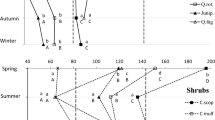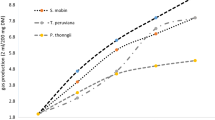Abstract
The availability of undergrowth is essential for integrating ruminant animals into oil palm plantations. This is because undergrowth can be used as a feed resource for ruminants. This type of production system has the advantage of diversifying income and controlling weeds in the plantation. At least fve botanical groups of herbage can be found in oil palm plantations, namely, grasses, broad leaved plants, legumes, ferns and palms. Grasses were found in abundant through all palm ages. Most grasses are tolerant to higher light intensity and some are shade-tolerant. This study showed that in the early stages of oil palm crop development, sun-loving species tend to dominate the field, mostly broad leaves and legumes, but they will gradually be replaced by shade-tolerant plants when the canopies close. Concentration of metabolizable energy in herbage on offer was 4.6 to 7.0 MJ/kg dry matter. Crude protein content of grasses, broad leaves, legumes, ferns and palms are 11.5%, 15.4%, 16.3%, 12.5% and 12.0%, respectively. Ruminant animals preferred broad leaved plants more than other botanical groups found in oil palm plantation. This paper showed that metabolizable energy available (MEA) models can be used for predicting available energy (MJ/ha/day) from the system for grazing ruminants. This is because MEA model was developed based on both quality and quantity of herbage present in the ecosystem.
Similar content being viewed by others
References
Anway JC (1978) A mammalian consumer model for grassland. In: Innis George S, ed, Grassland Simulation Model. Ecology Studies 26, pp 91–126. Springer-Verlag, New York
Arope Ani (1987) The roles of plantation sector in expanding livestock development in Malaysia. In: Proceedings 11th Annual Confcerence of Malaysian Society of Animal Production, Kuala Lumpur
Azli AMY (1988) Rumpai-Panduan Berilustrasi. Dewan Bahasa dan Pustaka, Kuala Lumpur, Malaysia, 219 pp
Black CC (1971) Ecological implications of dividing plants into groups with distinct photosynthetic production capacity. Adv Ecol Res 7: 87–114
Chen CP, Wong HK and Dahlan I (1991) Herbivores and the plantations. In: Ho YW et al., eds, Recent Advances on the Nutrition of Herbivores, pp 71–81. Malaysian Society of Animal Production
Dahlan I (1989) Modeling and simulation of herbage and cattle production systems under oil palm plantations in Malaysia. PhD dissertation, Kyoto Univ, 230 pp
Dahlan I, Mahyuddin MD, Yamada Y, Ahmad S and Izham A (1990) Modeling and Simulation of herbage production under oil palm plantation in Malaysia. In: Resource Utilization for Livestock Production in Malaysia. Proceedings of 13th MSAP Ann Conf, pp 1–8
Dahlan I, Yamada Y, Mahyuddin MD and Shahar MZ (1991) Application of modelling and expert system for livestock-crops integration. In: Ho YW et al., eds, Recent Advances on the Nutrition of Herbivores, pp 253–267. Malaysian Society of Animal Production
Goto I and Minson DJ (1977) Prediction of the dry matter digestibility of tropical grasses using a pepsincellulase assay. Animal Feed Science and Technology 2: 247–253
Kira T and Kumura A (1983) Dry matter production and efficiency in various types of plant canopies. In: Huxley PA, ed, Plant Research and Agroforestry, pp 347–364. ICRAF, Nairobi, Kenya
Lane, IR (1984) Natural forage for ruminants. In: Vijchulata P, BOngso TA, eds, Animal Production in Malaysia, pp 89–103. Faculty of Veterinary Medicine and Animal Science, Univ Pertanian Malaysia, Serdang, Selangor
MAFF (Ministry of Agriculture, Fisheries, and Food) (1975) Energy Allowances and Feeding Systems for Ruminants. Technical bull no 33, 79 pp
MAFF (Ministry of Agriculture, Fisheries, and Food) (1984) Energy Allowances and Feeding Systems for Ruminants. Technical bull no 433, 85 pp
Minson DJ and Milford R (1966) The energy value and nutritive value indices ofDigitaria decumbens, Sorghum almum, andPhaseolus atropurpureus. Aust J Agric Res 17: 411–423
SAS (Statistical Analysis System) (1988) SAS User's Guide: Statistics. SAS Inst Inc Cary, North Carolina, 585 pp
Tieszen LL (1970) Photosynthetic properties of some grasses in Western South Dakota. In: Proceedings South Dakota Academy of Science 49: 78–89
Tieszen LL (1983) Photosynthetic systems: Implications for agroforestry. In: Huxley PA, ed, Plant Research and Agroforestry, pp 323–346. ICRAF, Nairobi, Kenya
Wong CC, Rahim H and Mohd Sharudin MA (1985) Shade tolerance potential of some tropical forage for integration with plantations. 1. Grasses. MARDI Res Bull 13(3): 225–247
Author information
Authors and Affiliations
Rights and permissions
About this article
Cite this article
Dahlan, I., Yamada, Y. & Mahyuddin, M.D. Botanical composition and models of metabolizable energy availability from undergrowth in oil palm plantations for ruminant production. Agroforest Syst 24, 233–246 (1993). https://doi.org/10.1007/BF00705624
Issue Date:
DOI: https://doi.org/10.1007/BF00705624




